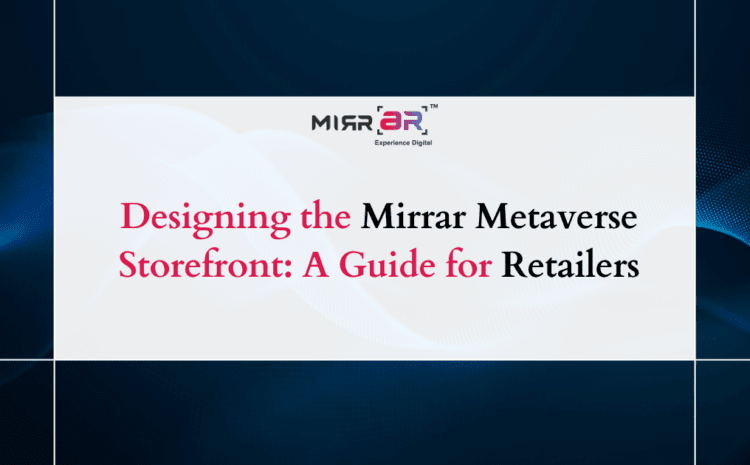The retail landscape is undergoing a once-in-a-generation transformation. Traditional e-commerce is no longer enough to capture customer attention, as shoppers crave experiences that are immersive, interactive, and personalized. The metaverse, powered by technologies like AR, VR, and 3D environments, is creating new opportunities for brands to reimagine digital retail. Platforms like Mirrar are at the forefront of this shift, enabling retailers to design virtual storefronts that don’t just replicate physical stores but elevate them.
But designing a storefront in the Mirrar Metaverse requires more than just uploading a catalog—it demands creativity, strategy, and an understanding of digital consumer psychology. This blog is a practical guide for retailers looking to build their presence in the Mirrar Metaverse and maximize its potential.
Understanding the Metaverse Storefront
A Mirrar Metaverse storefront is not just an online shop; it’s a 3D virtual destination where shoppers can explore products, try them on virtually, and interact with the brand in real time. Unlike traditional e-commerce, where the experience is linear (browse, add to cart, purchase), a metaverse storefront offers exploration and discovery. Customers can walk through digital aisles, attend virtual events, and even socialize with other shoppers.
The goal isn’t simply to mimic a physical store but to create an experience that could never exist offline—a blend of retail, entertainment, and community.
Step 1: Define the Brand Experience
Before diving into the design, retailers need to ask: What do we want customers to feel when they enter our Mirrar storefront?
If the brand is luxury, the environment should exude elegance with premium textures, soft lighting, and immersive details. For a streetwear label, the vibe might lean toward bold graphics, graffiti-inspired walls, and urban music. Ethnic fashion brands might replicate the feel of a cultural marketplace or a festive bazaar.
Defining the desired emotional response is the foundation for every design choice, ensuring the storefront tells a cohesive brand story.
Step 2: Prioritize Navigation and Accessibility
The metaverse offers endless creative freedom, but a cluttered or confusing environment risks frustrating shoppers. Just like a well-planned retail store has clear aisles and intuitive layouts, a Mirrar storefront should have simple, user-friendly navigation.
Key elements include:
- Clear pathways and hotspots that guide users toward featured collections.
- Interactive maps or “guided tours” for first-time visitors.
- Search and filter options that allow customers to quickly find products.
Accessibility is equally important. The storefront should be optimized to work smoothly across devices, from VR headsets to smartphones, so no shopper feels excluded.
Step 3: Make Products the Hero
At its core, a metaverse storefront still exists to showcase products. Retailers should ensure that items are displayed in engaging and interactive ways. Instead of flat product images, customers should see 3D renderings that can be rotated, zoomed, and tried on virtually using Mirrar’s VTO technology.
Dynamic product placement is key—highlighting bestsellers on virtual mannequins, creating themed sections for new arrivals, and using lighting effects to draw attention to exclusive collections. The goal is to replicate the tactile joy of in-store shopping while surpassing it with digital innovation.
Step 4: Integrate Virtual Try-On (VTO)
The real magic of a Mirrar storefront lies in its ability to integrate Virtual Try-On experiences. Customers can see how a necklace drapes, how a saree looks in motion, or how sunglasses fit their face in real time.
For retailers, this is not just a novelty—it’s a powerful conversion tool. VTO builds trust by reducing uncertainty, which leads to fewer returns and higher customer satisfaction. Designing storefronts with dedicated VTO stations or mirrors creates a natural flow where exploration leads directly to confident purchases.
Step 5: Infuse Interactivity and Gamification
One of the advantages of the metaverse is its potential for playful, interactive experiences. Retailers can go beyond selling to create engaging environments that encourage customers to linger.
Some ideas include:
- Reward-based treasure hunts across the store.
- Limited-time pop-up installations or seasonal décor.
- Interactive styling challenges where customers can mix and match outfits.
These gamified elements not only drive engagement but also encourage social sharing, amplifying brand visibility organically.
Step 6: Blend Commerce with Community
A metaverse storefront isn’t just a place to shop—it’s a social space. Retailers can host virtual events, from live product launches to Q&A sessions with designers, all within the Mirrar environment. Imagine a customer attending a virtual fashion show, then walking directly into the storefront to try on the showcased outfits.
Community features like chat zones or friend-invite shopping add a sense of belonging. Retailers who foster these connections can transform one-time shoppers into long-term loyalists.
Step 7: Measure and Optimize
Designing a Mirrar storefront is not a one-time effort—it’s an evolving journey. Retailers must track key metrics such as dwell time, most visited areas, VTO usage, and conversion rates. These insights help identify what works and where improvements are needed.
For instance, if data shows customers frequently abandon after exploring accessories, retailers might redesign that section for better flow or add interactive elements to re-engage interest. Regular updates also keep the storefront fresh and encourage repeat visits.
The Future of Retail Is Here
Designing a Mirrar Metaverse storefront is about more than aesthetics—it’s about crafting a living, breathing brand universe that blends commerce, creativity, and community. For retailers, the opportunity is immense: greater engagement, higher conversions, reduced returns, and stronger loyalty.
As 2025 unfolds, customers won’t just shop online; they’ll experience brands in ways that feel immersive, personal, and memorable. Retailers who embrace the Mirrar Metaverse today are not just keeping up with the future—they are helping define it.
